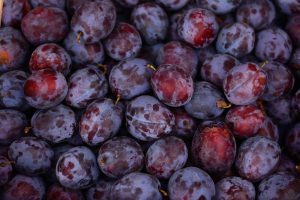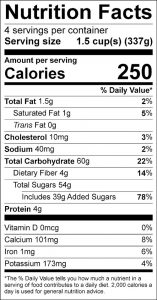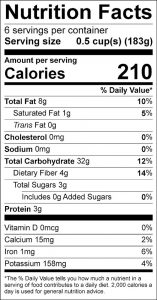Bulletin #4265, Vegetables and Fruits for Health: Plums and Pears

Revised and updated by Assistant Extension Professor Nadine Reimer, University of Maine Cooperative Extension.
Originally developed by Extension Nutrition Specialist Nellie Hedstrom, University of Maine Cooperative Extension.
For information about UMaine Extension programs and resources, visit extension.umaine.edu.
Find more of our publications and books at extension.umaine.edu/publications/.
Both plums and pears have been grown in North America for centuries. However, pears grown by European settlers were subject to a disease called fire blight. Although hybrid varieties have been developed that are resistant to the disease, pears are still not grown in great numbers in Maine. Most of the U.S. pear crop is grown in California and the northwestern states. Some comes from Michigan, New York, and Colorado. Plums were also grown by the colonists, but today most of the plum crop found in local markets is from the Northwest, California, and Michigan.
Nutrition Information
Plums and pears can provide nutrients to round out your daily needs. A serving is a whole plum or pear or, for cooked plums or pears, 1/2 cup. These fruits can help promote total nutrition and add variety to meals and snacks. Plums and pears are low in calories, low in fat, and a good source of vitamin C. They add significantly to a healthy diet.
Selection
There are four popular varieties of pears available: Bartlett in the summer, and Anjou, Bosc, and Comice in the fall and winter. Each has distinctive characteristics. Bartletts, which are often used for canning, are large and juicy, and are golden yellow when ripe. Sometimes they have a rosy blush color. Anjou pears are most available in the winter and the least expensive. They are oval-shaped and have a yellow-green skin. They may taste blander than other pear varieties. Bosc is noted for a long, tapered neck and reddish brown color. This pear is good for cooking or baking because of its firm flesh. Comice is sweet and flavorful and is sometimes known as “the dessert pear.”
Many varieties of plums are available. There are large red and purple plums and large yellow plums from California in summer and fall, and from South America in other seasons. Gages (juicy dessert fruits) and Damson varieties (used in preserves or jellies) are uncommon in the United States. Prune-type plums—sweet types that dry well—are primarily available as dried fruit from California.
Select plums that are plump, have firm flesh, and are fully colored for their variety. Don’t buy fruit that is mushy, has cracked skin, or is shriveled.
Storage
Pears are harvested from the orchard when they are fully grown, but still green and firm. Pears ripen as they travel to market and at home. As the fruit ripens, it will become juicer and sweeter. If you buy pears green, you can store them in the refrigerator to slow ripening. A couple of days before use, remove them from the refrigerator. Fruit ripens faster in a paper bag or perforated plastic bag. Never store or ripen pears in a sealed plastic bag. The fruit will turn brown in the center and not be good eating.
Buy firm plums and let them ripen at home. This fruit will not get sweeter as it softens, but it will get juicier. When the flesh is slightly soft at the stem end and tip, the fruit is ready to eat. Ripe plums will keep in the refrigerator for four or five days.
Preparation
As with all fruit that you eat without peeling, wash plums and pears before eating. They will be the sweetest and juiciest when you eat them at room temperature. Eaten at the peak of ripeness, pears are sweet and succulent. Under-ripe or overripe fruit will be less satisfactory.
Pears can be cooked by baking, sautéing, or poaching. Bartletts and Boscs hold their shape well when cooked. Spices such as cinnamon, cloves, nutmeg, or allspice make warm pears especially tasty. Pears sautéed in fruit juice, such as orange or pineapple, make a nice topping for frozen yogurt or plain yogurt.
Plums are especially colorful and can make an attractive salad. Or they can be made into a puree and added to desserts such as cakes, custards, or frozen desserts. They can also be baked or poached.
Pears with Yogurt Sauce
Serves 4
1 3/4 cups water
1/2 cup honey
2 cinnamon sticks (3 inches long)
4 medium pears, peeled, cored, and cut in half lengthwise
8 ounces low-fat vanilla yogurt
2 tablespoons low-fat sour cream
1 tablespoon honey
1/2 teaspoon vanilla flavoring
Make the yogurt sauce ahead: combine vanilla yogurt and the next three ingredients in a bowl, stir well. Cover and chill.
Cook pears by combining water and honey in a large, nonstick pan. Add cinnamon sticks. Arrange pear halves, cut sides down, in a single layer and bring to a simmer over medium heat. Cook for 10 minutes or until tender, basting and turning frequently for an even color. Remove pears from pan and put in a dessert serving dish. Set aside. Boil down the cooking liquid to 1/2 cup, remove cinnamon sticks. Pour liquid over pears.
To serve, put 2 pear halves on a dessert plate and top with 2 tablespoons yogurt sauce.
Pear Brown Rice
Serves 6
3 tablespoons lemon juice
2 teaspoons finely chopped garlic
1/4 teaspoons ground ginger
1/4 teaspoons ground black pepper
2 pears, diced
3 1/2 cups cooked brown rice
1/2 cup chopped green onions
1/2 diced celery
3 tablespoons vegetable oil
In a small bowl, combine lemon juice, garlic, ginger, and black pepper. Add pears to the mixture and set aside. In a large bowl, combine brown rice and remaining ingredients. Gently fold in pears. Serve immediately or chill in the refrigerator.
Some content adapted with permission from University of Massachusetts Cooperative Extension.
Information in this publication is provided purely for educational purposes. No responsibility is assumed for any problems associated with the use of products or services mentioned. No endorsement of products or companies is intended, nor is criticism of unnamed products or companies implied.
© 1997, 2009
Call 800.287.0274 (in Maine), or 207.581.3188, for information on publications and program offerings from University of Maine Cooperative Extension, or visit extension.umaine.edu.
In complying with the letter and spirit of applicable laws and pursuing its own goals of diversity, the University of Maine System does not discriminate on the grounds of race, color, religion, sex, sexual orientation, transgender status, gender, gender identity or expression, ethnicity, national origin, citizenship status, familial status, ancestry, age, disability physical or mental, genetic information, or veterans or military status in employment, education, and all other programs and activities. The University provides reasonable accommodations to qualified individuals with disabilities upon request. The following person has been designated to handle inquiries regarding non-discrimination policies: Director of Institutional Equity and Title IX Services, 5713 Chadbourne Hall, Room 412, University of Maine, Orono, ME 04469-5713, 207.581.1226, TTY 711 (Maine Relay System).



